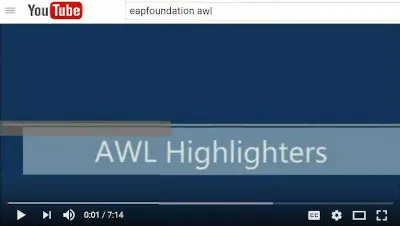Show AWL words on this page.
Show sorted lists of these words.


 







|
AWL highlighters: reviewReview date: 30 August, 2013
The AWL (Academic Word List) is widely used by EAP teachers and students. It is important, when learning vocabulary, to study words in context, so the AWL itself is not very useful except to identify academic words which EAP students could study. There are some useful AWL highlighters available online, which allow users to copy and paste a text and highlight all words from the AWL. Perfect! Instant context.
At the time of writing, there are three major AWL highlighters available on the web: one on the Lextutor website, one from Nottingham University, and the one from EAPFoundation.com (this website). Each of these is reviewed below, followed by a summary of the main features.
Lextutor

For another look at the same content, check out the video on YouTube (also available on Youku). There is a worksheet (with answers and teacher's notes) for this video.
The Lextutor website has many useful tools. Although many of these are aimed at researchers, it includes a vocabulary highlighter. It is not specifically an AWL highlighter, as it also highlights words from the GSL, broken down into two groups: K1 (the first 1000 words in the GSL) and K2 (the next 1000) words. It highlights the words using different colours: yellow for AWL words, blue for K1, green for K2, and red for 'off-list' words, i.e. words which are neither in the AWL of the GSL. It categorises the AWL words into the ten sublists. There are also many useful vocabulary exercises on the site, and a concordancer, so you can see more examples of words in context.
While there is no denying this is a fantastic website for EAP teachers and English language professionals, it is not such a great site for the EAP learner. There are two major drawbacks in my opinion. First, it is not very user friendly, perhaps because its main audience seems to be researchers, not students. The second problem is the ugly colour scheme. If you enjoy websites with black background and bright lettering, you'll be fine, but I personally don't.
Nottingham University
The Nottingham University highlighter is probably the most well-known highlighter. It certainly has the most links on the internet (try a search engine search to see for yourself). It is very simple, which means it is more user-friendly than the Lextutor highlighter. In addition to the highlighter, there is also a simple gapfill maker, which replaces all the AWL words in a text with blanks, so that you can test your knowledge of them. Unlike the Lextutor site, the Nottingham website has some general information about the AWL in addition to the highlighter. This site is clearly more geared to students that teachers or researchers.
The main positives of this site are its simplicity and user-friendliness. In a way, those are also its drawbacks: it is not as powerful or useful as either the Lextutor highlighter, or the highlighter on EAPFoundation.com.
EAPFoundation.com
OK, so first I should admit, I am quite biased, as this is the highlighter for this website. On the other hand, it should be noted that this highlighter was constructed with the others in mind. I was aware of their problems and limitations, and set out to create something which improved on them.
One thing I have been very conscious of with this site is making it user-friendly. The main audience is students, though teachers also benefit from it. The highlighter is easy for students to use. It is so easy that I included a version of it on every page (the AWL widget). The highlighter lists the words according to sublist (level), as I felt this was an important feature and the main thing lacking in the Nottingham highlighter. There is also information elsewhere on the site about the AWL, so students can understand it more fully. I also thought it would be good to make the highlighter more interactive: doing, not just seeing, appealing to kinaesthetic learning styles. There are therefore some nice ways to play around with the AWL words, e.g. changing the colours of the different levels, or using a tag cloud highlighter, which changes the size and colour of the words according to level. One weakness of students when learning vocabulary is to focus on meaning, without considering word families. I therefore felt it was essential to create a word family gapfill maker, so that students can explore different forms of the words being highlighted.
All of which sounds very positive, though I must admit, there are some drawbacks. The most significant one is that it is not possible to cut and paste the highlighted text*. I'm trying to fix that. Another is that all of the highlighter requires JavaScript. This isn't a problem for most users, though some users may have JavaScript turned off.
* Actually, this seems to be a browser related issue. Firefox (my preferred browser), Opera, and older versions of IE don't copy and paste, but Chrome and newer versions of IE (9 and above) all work fine.
Summary
Below is a summary of the main (positive) features of the highlighters, and which ones have these features. This should help you to choose the one which suits you best. The following code is used: Lex (Lextutor); Nott (Nottingham); EAPF (EAPFoundation).
Features |
Lex |
Nott |
EAPF |
user-friendly website |
 |
 |
 |
has information about the AWL in addition to AWL tools |
 |
 |
 |
highlights all words in the AWL |
 |
 |
 |
shows sublists for AWL words |
 |
 |
 |
interactive, e.g. user can change colour of sublists |
 |
 |
 |
different formats, e.g. word cloud AWL highlighter |
 |
 |
 |
simple gapfill maker |
 |
 |
 |
head word and word family gapfill maker |
 |
 |
 |
website also has a GSL highlighter |
 |
 |
 |
highlighted text is easy to copy and paste |
 |
 |
 |
works without JavaScript turned on |
 |
 |
 |



